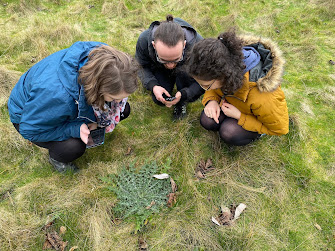February 2021 - finally time for bees (and spiders)
Slightly more creatures are finally emerging. The winter honeysuckle (Lonicera fragrantissima) in our garden was positively buzzing with bees this month. We had buff-tailed bumblebees (Bombus terrestris) and early bumblebees (B. pratorum) on the flowers and I managed to catch this honeybee (Apis mellifera) really filling up with honeysuckle pollen. It was fascinating to watch the honeybee combing the pollen into neat little balls to bring back to the hive for the larvae to eat.
 |
| Buff-tailed bumblebee (Bombus terrestris) on honeysuckle 26th February 2021 |
 |
| Honeybee (Apis mellifera) on honeysuckle 26th February 2021 |
As bumblebees and honeybees are both social bee species they have worker bees which go out to forage for the hive/colony and maintain the nest. Honeybee colonies are alive all year but workers won't be seen out in winter and they will instead use the food resources like honey they produced during the warmer months.
In comparison, bumblebees only have queens surviving over the winter and these queens are the first big bumblebees that you will see flying around. Once they have emerged from their winter hibernation, they will be foraging to collect pollen and nectar resources for the future colony. They will find a suitable nest site, usually in the ground or an abandoned mammal hole, and lay the first eggs which will develop into her first worker bees. These can be slightly smaller than the average worker bumblebee size for each species and will take over the job of foraging and nest maintenance once they are adults. This allows the queen to lay more eggs and expand her nest population, these continue to forage and care for the nest over summer. Towards the end of her colony lifespan, she will lay eggs which will develop into males and new queens. These will leave the nest and mate with other bumblebees from the same species but different colonies, mated queens will then begin hibernation and the males die. The cycle begins again with these queens coming out of hibernation the next year. BBCT have a nice generalised diagram for bumblebee lifecycles here.
I noticed that wildflowers like lesser celandine (Ficaria verna) and red dead-nettle (Lamium purpureum) were starting to flower to feed these early insects. The dead-nettles are good for bees with longer 'tongues' and celandines are good for insects with shorter tongues. Honeybees have much shorter tongues than some bees like the garden bumblebees (B. hortorum).
Now all the plants have been pruned, there are lots of clear basking spots and we have had loads of wolf spiders (Pardosa spp.) sunning themselves and running around the soil. Wolf spiders are tricky to identify to species without looking at certain anatomical features.
 |
| Wolf spider (Pardosa sp.) 26th February 2021 |
 |
| Aragog the Acromantula (based on a wolf spider) |
You can identify the wolf spider family (Lycosidae) if you see a fast spider with this eye arrangement: first row has four small eyes, middle row has two large eyes, and the top row has two medium sized eyes. The abdomen has hairs on and in early spring, you may often see females carrying egg sacks or their spiderlings on their abdomen.
The name comes from their behaviour of stalking prey and pouncing onto it like a wolf. If this is tricky to remember, imagine a tiny Aragog spider running around with no web.



Comments
Post a Comment